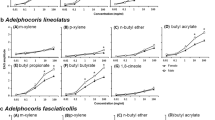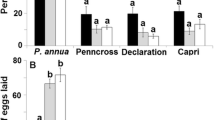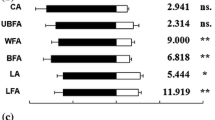Abstract
Dryocosmus kuriphilus is one of the most damaging pests of Castanea spp. Behavioral, chemical, and electrophysiological investigations were employed to examine the role of plant volatiles for host location by this thelytokuos cynipid. Y-tube olfactometer bioassays showed that adult wasps are significantly attracted by C. sativa twigs with at least 1-hr-old mechanical damage. Odors of undamaged host seedlings, intact twigs, and twigs with a fresh mechanical damage were not attractive. Wasps were repelled by plant materials of the non-host Prunus laurocerasus. Fourteen compounds, mainly general green leaf volatiles, were identified in the head-space of attractive host plant twigs by gas chromatography coupled to mass spectrometry. All compounds elicited dose-dependent antennal responses in adult wasps. A synthetic blend comprising all identified compounds in the same ratio as in the attractive host source induced significant positive responses in Y-tube olfactometer bioassays. The study gives a basis for future identification of host plant attractants that could contribute to semiochemical-based monitoring and management practices of this pest.

Similar content being viewed by others
References
Abe, Y., Melika, G., and Stone, G. N. 2007. The diversity and phylogeography of cynipid gallwasps (Hymenoptera: Cynipidae) of the Oriental and eastern Palaearctic regions, and their associated communities. Orient. Insects 41:169–212.
Abrahamson, W. G., Hunter, M. D., Melika, G., and Price, P. W. 2003. Cynipid gall-wasp communities correlate with oak chemistry. J. Chem. Ecol. 29:209–223.
Allison, S. D. and Schultz, J. C. 2005. Biochemical responses of chestnut oak to a galling cynipid. J. Chem. Ecol. 31:151–166.
Bech, J. J., Smith, L., and Merrill, G. B. 2008. In situ volatile collection, analysis, and comparison of three Centaurea species and their relationship to biocontrol with herbivory insects. J. Agric. Food Chem. 56:2759–2764.
Bernays, E. A., Oppenheim, S., Chapman, R. F., Kwon, H., and Gould, F. 2000. Taste sensitivity of insect herbivores to deterrents is greater in specialists than in generalists: a behavioural test of the hypothesis with two closely related catarpillars. J. Chem. Ecol. 26:547–563.
Bolter, C. J., Dicke, M., van Loon, J. J. A., Visser, J. H., and Posthumus, M. A. 1997. Attraction of Colorado potato beetle to herbivore-damaged plants during herbivory and after its termination. J. Chem. Ecol. 23:1003–1023.
Bruce, T. J. A., Wadhams, L. J., and Woodcock, C. M. 2005. Insect host location: a volatile situation. Trends Plant Sci. 10:269–274.
Chamberlain, K., Khan, Z. R., Pickett, J. A., Toshova, T., and Wadhams, L. J. 2006. Diel periodicity in the production of green leaf volatiles by wild and cultivated host plants of stemborer moths, Chilo partellus and Busseola fusca. J. Chem. Ecol. 32:565–577.
Den Otter, J. C., Tchicaya, T., and Schutte, A. M. 1991. Effects of age, sex and hunger on the antennal olfactory sensitivity of tsetse flies. Physiol. Entomol. 16:173–182.
Dickens, J. C. 2000. Orientation of Colorado potato beetle to natural and synthetic blends of volatiles emitted by potato plants. Agric. For. Entomol. 2:167–172.
Feder, J. L., and Forbes, A. A. 2007. Habitat avoidance and speciation for phytophagous insect specialists. Funct. Ecol. 21:585–597.
Forbes, A. A., Fisher, J., and Feder, J. L. 2005. Habitat avoidance: overlooking an important aspect of host-specific mating and sympatric speciation? Evolution 59:1552–1559.
Fraser, A. M., Mechaber, L. W., and Hildebrand, J. G. 2004. Electroantennographic and behavioural responses of the sphinx moth Manduca sexta to host plant headspace volatiles. J. Chem. Ecol. 29:1813–1833.
Germinara, G. S., De Cristofaro, A., Paparatti, B., Speranza, S., Stacchiotti, M., and Rotundo, G. 2009a. Electroantennographic responses of Dryocosmus kuriphilus to Castanea sativa leaf volatiles. Acta Hort. 844:387–394.
Germinara, G. S., De Cristofaro, A., and Rotundo, G. 2009b. Antennal olfactory responses to individual cereal volatiles in Theocolax elegans (Westwood) (Hymenoptera: Pteromalidae). J. Stored Prod. Res. 45:195–200.
Graus, M., Schnitzler, J.-P., Hansel, A., Cojocariu, C., Rennenberg, H., Wisthaler, A., and Kreuzwieser, J. 2004. Transient release of oxygenated volatile organic compounds during light-dark transitions in grey poplar leaves. Plant Physiol. 135:1967–1975.
Hoballah, M. E. and Turlings, C.J. 2005. The role of fresh versus old leaf damage in the attraction of parasitic wasps to herbivore-induced maize volatiles. J. Chem. Ecol. 31:2003–2018.
Kalberer, N. M., Turlings, T. C. J., and Rahier, M. 2001. Attraction of a leaf beetle (Oreina cacaliae) to damaged host plants. J. Chem. Ecol. 27:647–661.
Kato, K. and Hijii, N. 1997. Effects of gall formation by Dryocosmus kuriphilus Yasumatsu (Hym., Cynipidae) on the growth of chestnut trees. J. Appl. Entomol. 121:9–15.
Linn, C. Jr., Nojima, S., and Roelofs, W. 2005. Antagonistic effects of nonhost fruit volatiles on chemically-mediated discrimination of host fruit by Rhagoletis pomonella flies infesting apple, hawthorn (Crataegus spp.) and flowering dogwood (Cornus florida). Ent. Exp. Appl. 114:97–105.
Loughrin, J. H., Potter, D. A., Hamilton-Kemp, T. R., and Byers, M. E. 1996. Role of feeding-induced plant volatiles in aggregative behaviour of the Japanese beetle (Coleoptera: Scarabaeidae). Environ. Entomol. 25:1188–1191.
Payne, J. A., Jaynes, R. A., and Kays, S. J. 1983. Chinese chestnut production in the United States: practice, problems and possible solutions. Econ. Bot. 37:187–200.
Raguso, R. A. and Light, D. M. 1998. Electroantennogram responses of male Sphinx perelegans hawkmoths to floral and ‘green leaf volatiles’. Ent. Exp. Appl. 86:287–293.
Rojas, C. J. 1999. Electrophysiological and behavioural responses of the cabbage moth to plant volatiles. J. Chem. Ecol. 25:1867–1883.
Ronquist, F. and Liljeblad, J. 2001. Evolution of the gall wasp-host plant association. Evolution 55:2503–2522.
Ruther, J. 2000. Retention index database for identification of general green leaf volatiles in plants by coupled capillary gas chromatography-mass spectrometry. J. Chromatogr. A 890:313–319.
Ruther, J., Reinecke, A., Thiemann, K., Tolasch, T., Francke, W., and Hilker, M. 2000. Mate finding in the forest cockchafer, Melolonta hippocastani, mediated by volatiles from plants and females. Physiol. Entomol. 25:172–179.
Ruther, J., Reinecke, A., and Hilker, M. 2002. Plant volatiles in the sexual communication of Melolontha hippocastani: response towards time-dependent bouquets and novel function of (Z)-3-hexen-1-ol as a sexual kairomones. Ecol. Entomol. 27:76–83.
Sant’ana, J. and Dickens, J. C. 1998. Comparative electrophysiological studies of olfaction in predaceous bugs, Podisus maculiventris and P. nigrispinus. J. Chem. Ecol. 24:965–984.
Stone, G. N., Schönrogge, K., Atkinson, R. J., Bellido, D., and Pujade-Villar, J. 2002. The population biology of oak gall wasps (Hymenoptera: Cynipidae). Annu. Rev. Entomol. 47:633–668.
Takabayashi, J., Dicke, M., and Posthumus, M. A. 1994. Volatile herbivore-induced terpenoids in plant-mite interactions: variation caused by biotic and abiotic factors. J. Chem. Ecol. 20:1329–1354.
Tasin, M., Anfora, G., Ioriatti, C., Carlin, S., De Cristofaro, A., Schmidt, S., Bengtsson, M., Versini, G., and Witzgall, P. 2005. Antennal and behavioural responses of grapevine moth Lobesia botrana females to volatiles from grapevine. J. Chem. Ecol. 31:77–87.
Tasin, M., Backman, A. C., Bengtsson, M., Ioriatti, C., and Witzgall, P. 2006. Essential host plant cues in the grapevine moth. Naturwissenschaften 93:141–144.
Tooker, J. F. and Hanks, L. M. 2004. Stereochemistry of host plant monoterpenes as mate location cues for the gall wasp Antistrophus rufus. J. Chem. Ecol. 30:473–477.
Tooker, J. F., König, W. A., and Hanks, L. M. 2002. Altered host plant volatiles are proxies for sex pheromones in the gall wasp Antistrophus rufus. Proc. Natl. Acad. Sci. U.S.A. 99:15486–15491.
Tooker, J. F., Crumrin, A. L., and Hanks, L. M. 2005. Plant volatiles are behavioural cues for adult females of the gall wasp. Chemoecology 15:85–88.
Turlings, T.C.J., Urs, B., Lengwiler, U.B., Bernasconi, M.L., and Wechsler, D. 1998. Timing of induced volatile emissions in maize seedlings. Planta 207:146–152.
Ukeh, D. A., Birkett, M. A., Bruce, T. J. A., Allan, E. J., Pickett, J. A., and Mordue (Luntz) A. J. 2010. Behavioural responses of the maize weevil, Sitophilus zeamais, to host plant (stored-grain) and non-host plant volatiles. Pest Manag. Sci. 66:44–50.
van Tol, R. W. H. M., Visser, J. H., and Sabelis, M. W. 2002. Olfactory responses of the vine weevil, Otiorhynchus sulcatus, to tree odours. Physiol. Entomol. 27:213–222.
van Tol, R. W. H. M., Visser, J. H., and Sabelis, M. W. 2004. Behavioural responses of the vine weevil, Otiorhyncus sulcatus, to semiochemicals from conspecifics, Othiorhyncus salicicola, and host plants. Ent. Exp. Appl. 110:145–150.
Visser, J. H. 1986. Host odor perception in phytophagous insects. Annu. Rev. Entomol. 31:121–144.
Zhu, D-H., He, Y-Y., Fan, Y-S., Ma, M-Y., and Peng, D-L. 2007. Negative evidence of parthenogenesis induction by Wolbachia in a gallwasp species, Dryocosmus kuriphilus. Ent. Exp. Appl. 124:279–284.
Acknowledgments
This research was partly supported by the Campania Region, Contribution number 28/08 of the research program: “Studio per il controllo ecocompatibile del Cinipide del castagno”.
Author information
Authors and Affiliations
Corresponding author
Rights and permissions
About this article
Cite this article
Germinara, G.S., De Cristofaro, A. & Rotundo, G. Chemical Cues for Host Location by the Chestnut Gall Wasp, Dryocosmus kuriphilus . J Chem Ecol 37, 49–56 (2011). https://doi.org/10.1007/s10886-010-9893-0
Received:
Revised:
Accepted:
Published:
Issue Date:
DOI: https://doi.org/10.1007/s10886-010-9893-0




